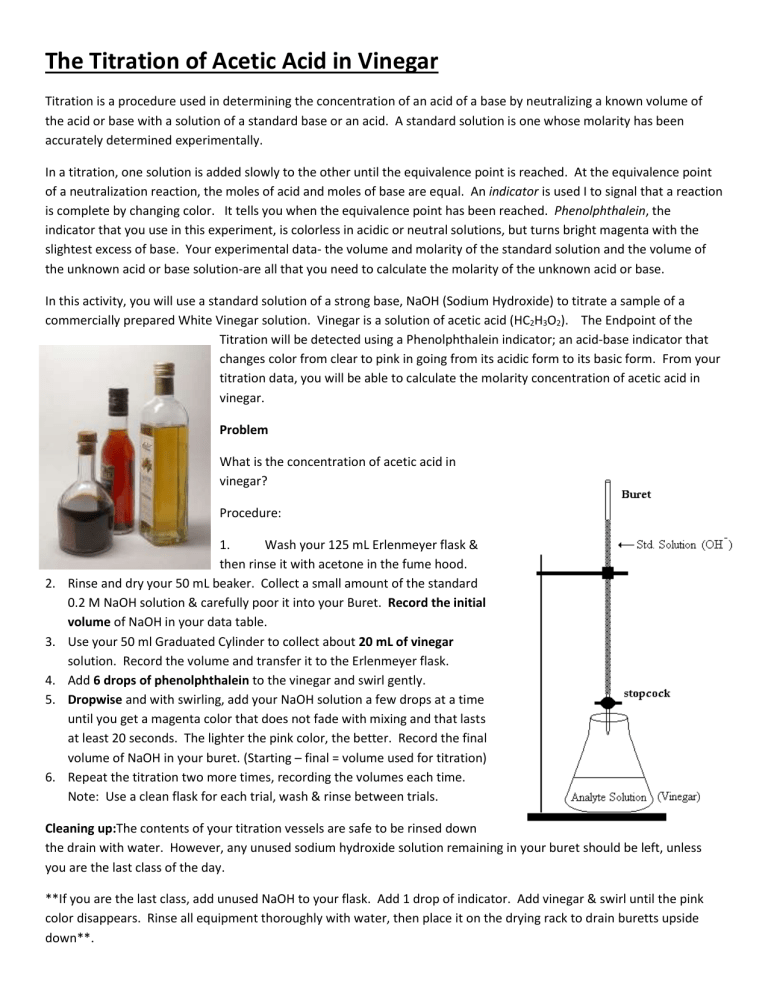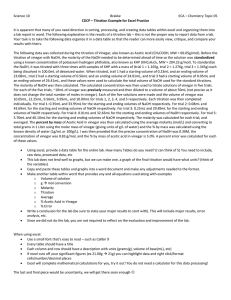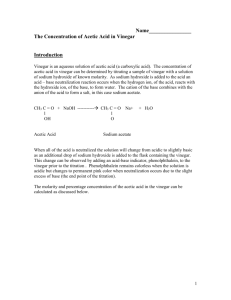The Titration of Acetic Acid in Vinegar

The Titration of Acetic Acid in Vinegar
Titration is a procedure used in determining the concentration of an acid of a base by neutralizing a known volume of the acid or base with a solution of a standard base or an acid. A standard solution is one whose molarity has been accurately determined experimentally.
In a titration, one solution is added slowly to the other until the equivalence point is reached. At the equivalence point of a neutralization reaction, the moles of acid and moles of base are equal. An indicator is used I to signal that a reaction is complete by changing color. It tells you when the equivalence point has been reached. Phenolphthalein, the indicator that you use in this experiment, is colorless in acidic or neutral solutions, but turns bright magenta with the slightest excess of base. Your experimental data- the volume and molarity of the standard solution and the volume of the unknown acid or base solution-are all that you need to calculate the molarity of the unknown acid or base.
In this activity, you will use a standard solution of a strong base, NaOH (Sodium Hydroxide) to titrate a sample of a commercially prepared White Vinegar solution. Vinegar is a solution of acetic acid (HC
2
H
3
O
2
). The Endpoint of the
Titration will be detected using a Phenolphthalein indicator; an acid-base indicator that changes color from clear to pink in going from its acidic form to its basic form. From your titration data, you will be able to calculate the molarity concentration of acetic acid in vinegar.
Problem
What is the concentration of acetic acid in vinegar?
Procedure:
1.
Wash your 125 mL Erlenmeyer flask & then rinse it with acetone in the fume hood.
2.
Rinse and dry your 50 mL beaker. Collect a small amount of the standard
0.2 M NaOH solution & carefully poor it into your Buret. Record the initial
volume of NaOH in your data table.
3.
Use your 50 ml Graduated Cylinder to collect about 20 mL of vinegar solution. Record the volume and transfer it to the Erlenmeyer flask.
4.
Add 6 drops of phenolphthalein to the vinegar and swirl gently.
5.
Dropwise and with swirling, add your NaOH solution a few drops at a time until you get a magenta color that does not fade with mixing and that lasts at least 20 seconds. The lighter the pink color, the better. Record the final volume of NaOH in your buret. (Starting – final = volume used for titration)
6.
Repeat the titration two more times, recording the volumes each time.
Note: Use a clean flask for each trial, wash & rinse between trials.
Cleaning up:The contents of your titration vessels are safe to be rinsed down the drain with water. However, any unused sodium hydroxide solution remaining in your buret should be left, unless you are the last class of the day.
**If you are the last class, add unused NaOH to your flask. Add 1 drop of indicator. Add vinegar & swirl until the pink color disappears. Rinse all equipment thoroughly with water, then place it on the drying rack to drain buretts upside down**.
Name: _____________________________________
Data, Observations, Calculations, & Conclusions
Pre-lab Questions
1. Briefly explain what happens in a neutralization reaction.
2. What is a standard solution?
3. What is the equation used to determine the percent error?
4. Write the equation for the reaction between acetic acid (HC
2
H
3
O
2
) and NaOH.
5. What is the purpose of the indicator? How does it tell you the reaction is complete?
Data & Calculations
Initial Volume of NaOH
Final Volume of NaOH
Trial 1
Amount of NaOH added
Volume of vinegar titrated
Concentration of acetic acid in vinegar
(show calculation & result
Trial 2 Trial 3
Analysis & Calculations
1.
In the above table, calculate the volume of standard NaOH used to titrate the vinegar in each trial
2.
Use M
A
V
A
= M
B
V
B
to calculate the concentration of acetic acid in vinegar for each trial.
Coef
A
Coef
B
3.
Determine the average molarity of your vinegar solution.
4.
If the actual concentration of acetic acid in vinegar is 0.64 M, what is the percent error?
5.
What effect would each of the following have on the molarity of your acid solution? a.
Rather than the desired light pink color, a bright magenta color marked the endpoint of the titration. b.
The flask was not swirled during the titration, and the experiment was stopped at the first sign of pink.









